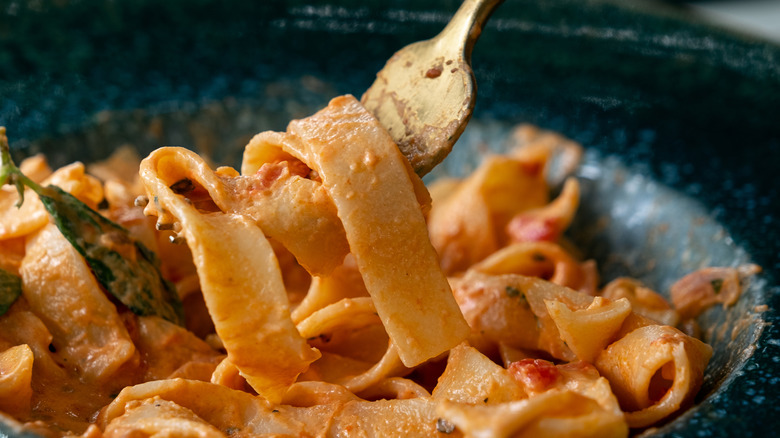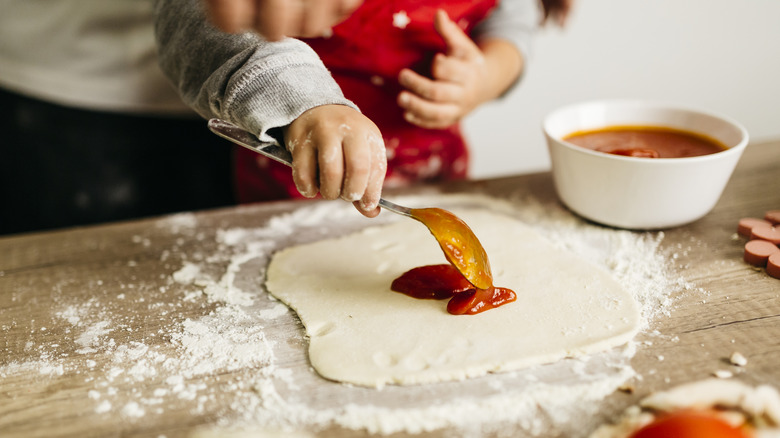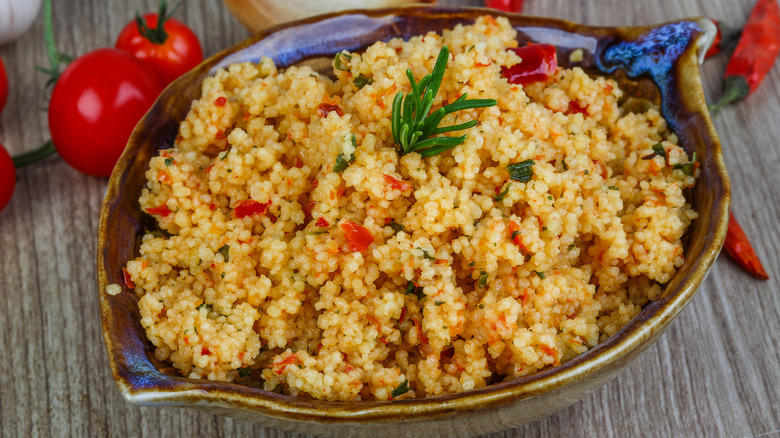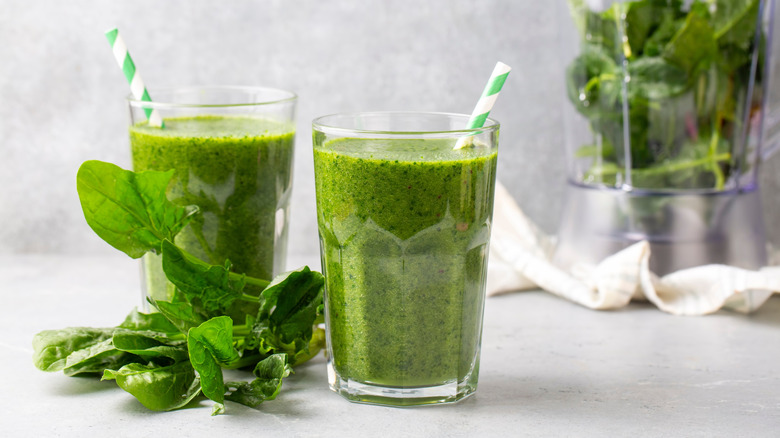12 Creative Ways To Use Up Leftover Soup
Soup is the ultimate winter comfort food. Warm, nourishing, and satisfying — it's the perfect dish for cozy nights and chilly days, made even more appealing by the fact that it's super adaptable. Indeed, the ease with which soup can be whipped up, makes it a go-to for most of us. However, despite the undeniable appeal, there are times when it can feel somewhat uninspiring. If you've ever made a big batch and planned to eat it every night for the rest of the week, you'll know the feeling. On day three, the dish that was originally hearty and indulgent now feels a little monotonous. Reheating another portion may not sound that appealing, but there's no reason to let it sit in the fridge or throw it away, as there are many creative ways to give that leftover soup a second life.
From crafting creamy dips to tasty pizza sauces, you'd be surprised how versatile your leftover soup can be. It works great at adding flavor and moisture, but it also easily transforms into a completely new dish. Whether you have an entire pot to use or just one portion, you're guaranteed to find a delicious and exciting use for your soup on the list. There's no need to tuck into your sixth bowl this week.
Make a speedy pasta sauce
Transforming your leftover soup into a tasty pasta sauce is one of the easiest hacks for ensuring a quick and fuss-free dinner that does not compromise on flavor. Whether the leftover soup you have is a creamy vegetable soup or a thinner broth, with just a few simple steps, you can swiftly turn it into a rich and flavorful sauce. This is a particularly good idea if you're looking to add a little more sustenance to your meal but still want to enjoy the same flavors you've built into your soup.
To create the ideal sauce that coats your pasta properly, you'll want to start by reheating the soup and then letting it simmer and reduce until it reaches the desired consistency. The thickness will depend on the type of pasta you plan to use and the type of soup that you are working with. A thinner soup, like a meaty broth, will require more time to cook down to reach the texture ideal for clinging to the pasta. A thick soup will probably not need long, and it may even benefit from a splash of pasta water, broth, or wine, just to thin it out slightly. Besides the consistency, the method will help concentrate flavors, and once you get the ideal texture, you can adapt it with add-ins, such as fresh herbs, a drizzle of olive oil, or your favorite seasoning.
Transform it into a creamy dip
If you're after a new way of enjoying leftover soup that doesn't involve creating a whole meal, consider turning it into a creamy dip for a flavor-packed snack. This is a great way to upgrade your leftovers as these dips can be incredibly versatile and are perfect for pairing with chips, chopped vegetables, or plain crusty bread. This hack works particularly well with thick and creamy soups, as they require little work to become a luscious dip. Apart from thin, brothy versions, most soups can transform into a creamy combination with a simple simmer and a few extra ingredients.
The preparation is similar to the sauce method. Start by reducing the soup until it becomes considerably thicker. You'll then add some cheese and mix until everything blends well. The cheese will provide more body and the stretchy, gooey consistency will make the whole thing way more indulgent. Cheddar and mozzarella are both excellent choices due to their stringy texture and mild tanginess, but you can experiment with other varieties. Also, make sure the cheese pairs with the dominant flavors in the soup. Sour cream may also serve as a wonderful addition, particularly alongside onion to make the perfect version of the sour cream and onion dip.
Use it for quick and easy risotto
Risotto is an indulgent and comforting dish, but it is also time-consuming to make from scratch. The preparation involves adding stock, a ladle at a time, until all of the liquid is gradually absorbed by the rice, resulting in a dish with an incredibly creamy texture. If you're after the same level of creaminess but don't have a lot of time on your hands, your leftover soup may offer the perfect solution. You can simply use the soup with or instead of the stock when you're whipping up risotto. The soup will impart layers of flavor and cut down on prep time.
The soup can be added at the same time as the store-bought broth when making risotto. You won't need to work in such small increments to ensure a creamy texture since the thicker consistency of the soup works better at delivering velvety smooth results. Even if you are working with thinner varieties, the prep won't last as long, as most of the seasoning your risotto needs will come from the soup. The only thing you need to worry about is how to get that signature texture. Even if you have your favorite risotto broth on hand, consider substituting a part of it with a creamy soup for a more flavor-packed and luxurious risotto without the extra prep.
Bulk it up and make a casserole
Though soup is a warm and nourishing dish, there are times when you may feel the need for a heartier and more substantial meal. When this happens, don't ignore the soup stacked in the fridge, as it provides a perfect base for a robust dish that will keep you satisfied long after eating. Leftover soup can be turned into a comforting and filling casserole with the addition of a few extra ingredients. Regardless of whether you have leftover tomato soup, chicken noodle soup, or a thick and creamy variety like the loaded cheeseburger soup, the right pairings can transform it into a delicious one-pot meal.
We love casseroles because of their versatility, as you can use whatever you have on hand to create a dish that suits your taste. Adding a starchy component, such as potato, rice, or pasta, is always a good start. Cheesy, creamy soups like French onion soup are especially suitable for this method. The starch will absorb some of the soupy liquid together with the nuanced flavor, serving as a solid foundation for a cohesive dish. Additional mix-ins such as meat or beans can help to make the dish heartier, while a sprinkle of cheese or a handful of crispy fried onions over the top can add an interesting texture and an extra indulgent touch.
Reduce it and make gravy
Rich and savory gravy is one of the best complements to the main course, bringing an extra dimension with its luxurious texture and incredible depth of flavor. If you're planning on serving your next meal with the gravy, make sure to hold back some of your leftover soup. Hearty meat broths, creamy vegetable soups, and even traditional tomato varieties can be transformed into thick, delicious gravies perfect for drizzling over creamy mashed potatoes, crumbly meatloaf, or succulent roasts.
Start by reducing your soup if necessary. While thick soups require some simmering and perhaps some extra liquid, thinner soups or broths may not need to be reduced. Instead, you might want to thicken them with a classic slurry that combines cornstarch and water until you reach the perfect consistency. To ensure that velvety smooth texture that we all associate with gravy, it's essential to strain the soup after it's been reduced or thickened. This step is important as it removes all large chunks of meat or vegetables before adding additional herbs or seasonings as the finishing touch. The main flavors of the soup will remain in the gravy, so make sure the flavor profile matches the main course.
Bake soup-infused bread
If you've ever tried switching up the way you serve your soup, you may have experimented with serving various soups in bread bowls. There's no doubt that crisp bread and warm, comforting soup go hand in hand, but making a bread bowl is not the only way to combine these two staples. You can go a step further by incorporating leftover soup directly into a loaf of bread. The method is a great way to turn an ordinary loaf into something truly unique. Adding soup to your dough can result in a version that boasts depth and a distinct richness. Think of a fragrant rosemary focaccia with the subtle taste of chicken and mushroom soup or a gooey grilled cheese made with bread infused with a tomato-based soup.
To incorporate your leftover soup into bread dough, simply replace some or all of the water with the soup. How much you substitute will depend on the consistency of the soup you are using. If you are using a thin broth, you will likely be able to substitute all of the water with the soup. In this version, be mindful of the salt and the impact it will have on your final loaf. Thicker soups will probably need to be adjusted with water to ensure that the dough comes together properly and does not fall apart or dry out.
Stuff baked potatoes with it
For many people, baked potatoes and a warming soup are some of the most comforting dishes. As such, it makes sense that when the two are combined, the result is even more indulgent. While you may be more familiar with conventional toppings such as chives, bacon, or a generous slab of butter, there are many unexpected toppings that can easily upgrade baked potatoes. To expand it further, we can add soup to the list. The result is a perfect blend of a juicy, fluffy center and a crisp exterior. The combination is hard to top, regardless of which soup you use.
To create this ultimate comfort food, reheat the soup while the potatoes are in the oven. Once the outside start to crisp up, take them out, gently slice them open, and spoon your soup inside the crevice. You can then serve your finished potatoes as is or, depending on your soup, customize them further with additional toppings such as shredded cheese or extra protein. Once you incorporate all the add-ins, put the potatoes back in the oven for a few minutes, allowing the cheese to melt and the flavors to blend properly.
Spread it on pizza
Leftover soup can be a game-changer when it comes to making homemade pizza, offering a flavorful base that will most likely top your favorite store-bought tomato sauce. Thickened homemade tomato soup is bound to offer freshness and depth of flavor that cannot be replicated, while creamy vegetable soups or meat-based variations can provide a unique and creative twist for white pizzas.
Some soups may be suitable for swirling straight onto your pizza dough, but you may need to thin out thicker varieties with water, broth, or cream. When it comes to toppings, the choice mostly comes down to personal preference. However, for the most cohesive and nuanced versions and to get the most out of your leftover soup, consider choosing toppings that complement the flavors of your soup. Rotisserie chicken will work beautifully on top of a chicken and mushroom sauce, while roasted red peppers make an excellent accompaniment to a tomato soup. Roasted vegetables such as zucchini, squash, or pumpkin, paired with herbs like sage or rosemary, should work well with butternut squash soup.
Use it in place of stock or water for tasty grains
If you're after a simple way to upgrade your side dishes, consider cooking your grains in leftover soup. The rich flavors of the soup can bring a whole new lease of life to grain-based dishes, turning a pleasant accompaniment into a star of the show. There is no reason to cook your lentils, couscous, or quinoa in plain water if you have a pot filled with a flavor-packed soup. Allowing the grains or legumes to soak up all the lip-smacking goodness delivers on the flavor front, but it also grants a creamier texture. This method is a no-brainer if you have grains and leftover soup in your kitchen.
The entire process doesn't require any additional effort. All you need to do is bring the soup to a boil, add your uncooked grains, lower the heat, and leave it to simmer. Keep an eye on the grains as you cook. Those prepared with thicker soups may need liquid to ensure they don't dry out or burn.
Add it to mashed potatoes
The key to truly great mashed potatoes is ensuring the creamiest possible texture. Typically, milk and butter are the go-to ingredients for achieving a soft and fluffy version of this classic. However, there are many ingredients that can upgrade mashed potatoes, and you could also add leftover soup to the list. Use the mushroom version for a rich texture and earthy flavor or opt for tomato soup to add a pop of color and a tangy twist. As mashed potatoes are incredibly adaptable, virtually any flavor could work.
When making your mashed potatoes with leftover soup, prep your potatoes as usual. Add some butter and start the mashing process. Instead of milk, pour your favorite soup and continue mashing, gradually adding more until the potatoes reach the desired consistency. If you're particularly interested in making your potatoes a little lighter, you could use the soup as a substitute for the butter and milk, but keep in mind that this works best with thicker soups that already incorporate cream or other fatty ingredients.
Blend it into green smoothies
It may seem a little questionable to imply you should blend a savory soup and a smoothie, but there are occasions where this idea works incredibly well. You may want to find another way to repurpose a cheesy French onion soup or pork ramen, but if you have delicate vegetable-based soup, incorporating it into a smoothie is an excellent way to enjoy it.
Carrot soups, for instance, whether flavored with warming cumin or zesty cilantro, are the optimal base for green smoothies, especially if sweetened with apple juice and boosted with an invigorating ginger. Similarly, butternut squash soup with its creamy consistency and delicate sweetness is suitable for pairing with many other vegetables. It can also work with mangoes, dates, and bananas, as an ideal choice for those who are still a little unsure about savory smoothies. If the notion still seems odd, simply blend your green smoothie as usual, or follow a recipe that sounds appealing, and substitute some water with your soup. Taste continuously to make sure the flavors of the soup do not overwhelm the drink. If the taste is already prominent, but the smoothie is still too thick, switch back to water.
Freeze into cubes to use later
If you have a particularly large volume of leftover soup and no realistic means of using it any time soon, freezing it into cubes is a smart way to preserve it and cut back on the prep time in the future. Pour your leftover soup into ice cube trays and pop them into the freezer. When set, transfer the cubes in an air-tight container or into freezer bags.
These small, pre-portioned cubes of soup can later be reheated in bulk when you're craving soup but don't want to make it from scratch. However, they can also add flavor and depth to an array of other dishes. One or two cubes can be dropped into stews, casseroles, or sauces for a quick flavor boost that delivers more nuance and complexity than store-bought stock. Add some cubes into various veggie soups for an extra layer of flavor or to impart a savory note to a tomato-based version. Frozen cream soups can also give any dish a creamy textural component. Whatever you use these frozen cubes for, it's good to know you have a great source of flavor and a fuss-free foundation for a quick and easy meal waiting in the freezer.












